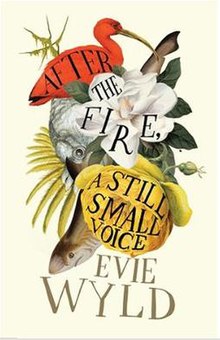After the Fire, A Still Small Voice is the debut novel by author Evie Wyld published in August 2009 by Jonathan Cape in the UK and Pantheon Books in the US.[1] It won the John Llewellyn Rhys Prize[2] and a Betty Trask Award.[3] and was also shortlisted for both the Orange Award for New Writers[4] and International Dublin Literary Award.[5]
 First UK edition | |
| Author | Evie Wyld |
|---|---|
| Cover artist | Wallzo |
| Language | English |
| Publisher | Jonathan Cape (UK) Pantheon (US) |
Publication date | 2009 |
| Publication place | United Kingdom |
| Media type | Print, Audio & eBook |
| Pages | 304 |
| Awards | Betty Trask Award John Llewellyn Rhys Prize |
| ISBN | 0-224-08887-4 |
| 823/.92 | |
| LC Class | PR6123.Y43 A69 2009 |
Plot introduction
editThe story is set in Queensland[6] on the East Coast of Australia and concerns two men from different generations, as described in the blurb on the back cover of the 2010 Vintage edition:
- Frank is trying to escape his troubled past by running away to his family's beach shack. As he struggles to make friends with his neighbours and their precocious young daughter Sal, he discovers the community has fresh wounds of its own. A girl is missing, and when Sal too disappears, suspicion falls on Frank.
- Decades earlier, Leon tries to hold together his family's cake shop as their suburban life crumbles in the aftermath of the Korean War. When war breaks out again, Leon must go from sculpting sugar figurines to killing young men as a conscript in the Vietnam War.
Title
editReception
edit- Lee Rourke in The Independent on Sunday writes: "Landscape plays a major role in Wyld's writing. It opens up the narrative, creating an eerie metaphorical space, or silence, between each character, mirroring the physical and mental fissures that separate each generation. Although nothing is truly silent: even the landscape is "thick with insect noise". The power of this mesmerising novel hangs on the premise that silence is impossible, while such impossibility forces the men who litter its landscape to desire it all the more." and Rourke concludes: "Wyld's writing is assured enough to elongate metaphor and symbolism, creating a novel both taut and otherworldly. This adroit examination of loss, lostness and trauma is the beginning of great things".[8]
- The Observer has the following praise from Francesca Segal, "The landscape of Australia's east coast looms large in the book, wild and sinister, filled with light and tragedy. This is a sad and lovely novel from a talented new writer".[6]
- The New Yorker praises the novel: "Wyld has a feel both for beauty and for the ugliness of inherited pain. The mood is creepy—strange creatures in the sugar cane, grieving neighbors, a missing local girl—and the sentiment is plain: 'Sometimes people aren't all right and that's just how it is.'"[9]
References
edit- ^ "After the Fire, a Still Small Voice by Evie Wyld". Fantasticfiction.co.uk. Retrieved 30 November 2011.
- ^ Previous winners of the John Llewellyn Rhys Prize Archived 1 April 2012 at the Wayback Machine
- ^ "The Betty Trask Prize and Awards". Christchurch City Libraries. 3 February 2011. Retrieved 30 November 2011.
- ^ "Orange newsroom | Orange Award for New Writers Announces 2010 Shortlist". Newsroom.orange.co.uk. Archived from the original on 27 September 2011. Retrieved 30 November 2011.
- ^ McDonald, Andrew (13 April 2011). "Malouf, Silvey, Wyld make IMPAC Literary Award shortlist ·". Readings.com.au. Retrieved 30 November 2011.
- ^ a b Francesca Segal (6 September 2009). "After the Fire, a Still Small Voice by Evie Wyld". The Guardian. London. Retrieved 30 November 2011.
- ^ "After the Fire a Still Small Voice ~ Evie Wyld – dovegreyreader scribbles". Dovegreyreader.typepad.com. 19 April 2010. Retrieved 4 December 2011.
- ^ Lee Rourke (23 September 2009). "After The Fire, A Still Small Voice, By Evie Wyld – Reviews – Books". The Independent. London. Archived from the original on 25 September 2009. Retrieved 30 November 2011.
- ^ Review in The New Yorker Retrieved 04/01/2023.
External links
edit- In Conversation with Evie Wyld, author of After the Fire, A Still Small Voice
- After the award, a humble happy Evie...
- Wyldfire: An interview with Evie Wyld
- Emma Gibson interviews talented new writer Evie Wyld
- Evie Wyld on After The Fire, A Still Small Voice from YouTube
- Evie Wyld talks about After The Fire, A Still Small Voice from YouTube
- Evie Wyld discusses her first novel, After the Fire